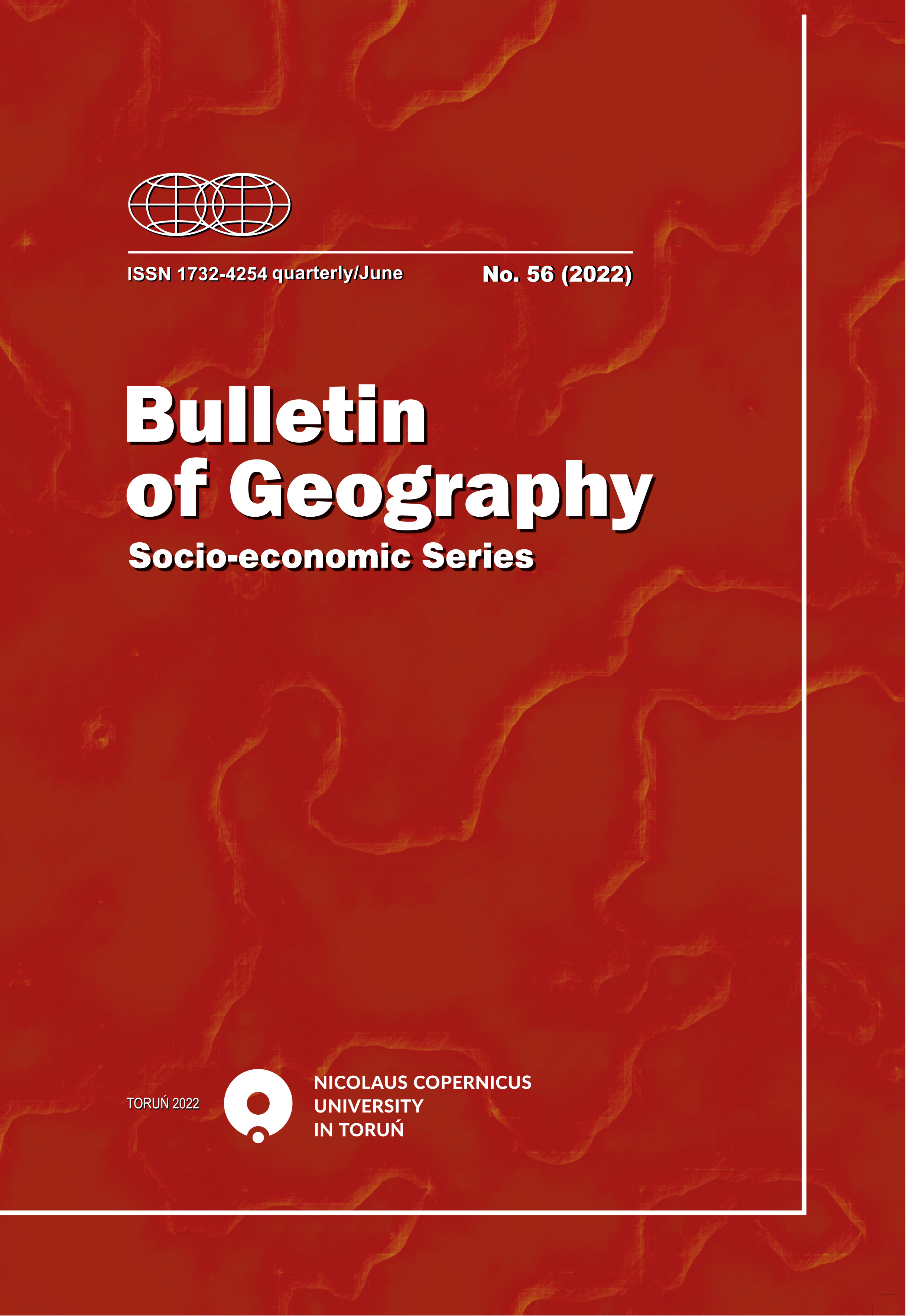A full permutation polygon synthetic indicator (FPPSI) approach for measuring and evaluating city prosperity: case study in Da Nang City, Vietnam
DOI:
https://doi.org/10.12775/bgss-2023-0011Keywords
urban studies, measurement of prosperity, Full Permutation Polygon Synthetic Indicator (FPPSI) method, Da Nang City, VietnamAbstract
Economic growth has dominated development strategies and goals for many years, but prosperity encompasses more than that. In 2013, UN-Habitat proposed the City Prosperity Initiative (CPI) as a tool to quantify cities' prosperity and sustainable development. The CPI is accompanied by six essential components with 62 indicators associated with the urban settlement, incorporating productivity,
infrastructure development, quality of life, social inclusion, environmental sustainability, and urban governance and legislation. The research aims to use the indicators of CPI and adopted the Full Permutation Polygon Synthetic Indicator method to measure and evaluate the level of prosperity of Da Nang City of Vietnam with data from 2004 to 2019. According to the findings of our study, the value of a synthetic indicator for the prosperity of Da Nang City increased, from 0.34 in 2004 to 0.36 in 2009, 0.43 in 2014, and 0.45 in 2019, which indicates a moderate level of wealth. On the one hand, Da Nang City has high levels of quality of life, equity and social inclusion, and urban governance and legislation. However, the city still has modest determinants of prosperity in terms of the environment, productivity and infrastructure. The Full Permutation Polygon Synthetic Indicator technique provides a comprehensive solution that illustrates the system integration idea. As a result, the proposed methodology offers a potential foundation for decision-making to promote sustainable urban development strategies and assess the effectiveness of these actions
References
Arbab, P. (2017). City Prosperity Initiative Index: Using Ahp Method To Recalculate the Weights of Dimensions and Sub- Dimensions in Reference To Tehran Metropolis. European Journal of Sustainable Development, 6(4): 289–301. DOI: https://doi.org/10.14207/ejsd.2017.v6n4p289.
Da Nang City Statistics Office (2021). Danang City Statistical Yearbook 2020. Statistical Publishing House.
Feng, Li., Liu, X., Hu, D., Wang, R., Yang, W., Li, D. & Zhao, D. (2009). Measurement indicators and an evaluation approach for assessing urban sustainable development: A case study for China’s Jining City. Landscape and Urban Planning, 90(3–4): 134–142. DOI: https://doi.org/10.1016/j.landurbplan.2008.10.022.
General Statistics Office (2018). The Vietnam Informal Employment Report. Hong Duc Publishing House.
General Statistics Office (2010, 2015, 2020). The Vietnam Population and Housing Census 2009, 2014, 2019. Statistical Publishing House.
General Statistics Office (2005, 2009, 2015, 2019). The Vietnam Household Living Standards Survey 2004, 2008, 2014, 2018. Statistical Publishing House.
General Statistics Office (2005, 2010, 2015, 2020). Statistical Yearbook of Viet Nam 2004, 2009, 2014, 2019. Statistical Publishing House.
Institute of Socio-Economics of Can Tho City (2019). 2018 City Prosperity Report of Can Tho City - Vietnam. Can Tho: Institute of Socio-Economics of Can Tho City.
Jackson, T. (2009). Prosperity Without Growth: Economics for a Finite Planet. London: Earthscan.
Malesky, E.J., Tuan, D.A., Thach, P.N., Ha, L.T., Thu, T.M., Ngoc, P.T., Trong, T.D., Nghia, N.T. Le & Ha, N.Le. (2020). The Vietnam Provincial Competitiveness Index PCI 2020. Hanoi: Vietnam Chamber of Commerce and Industry.
Sachs, J.D. (2015). The Age of Sustainable Development. New York: Columbia University Press.
Sasaki, R. (2014). Urban Prosperity without Growth? Sustainable City Development with Focus on Human Flourishing. Lund, Sweden: Master thesis of Lund University Centre for Sustainability Studies.
Socialist Republic of Vietnam (2015). 15 Years Achieving The Vietnam Millennium Development Goals. Ha Noi: Socialist Republic of Vietnam.
Socialist Republic of Vietnam (2018). Voluntary National Review Report On the Implementation of Sustainable Development Goals. Ha Noi: Socialist Republic of Vietnam.
UN-Habitat (2015). 2015 Global City Report. New York: International City Leaders (ICL).
UN-Habitat (2019). CPI Profile Taif. Saudi Arabia - Al-Taif: Ministry of Municipal and Rural Affairs and United Nations Human Settlements Programme.
UN Habitat (2013). State of the World’s Cities Report 2012: Prosperity of Cities. New York: Routledge.
UN Habitat (2016). City Prosperity Index: Methodology and Metadata. New York: United Nations Human Settlements Programme (UN-Habitat).
United Nations (2018b). World Urbanization Prospects: The 2018 Revision. New York: The Department of Economic and Social Affairs of the United Nations.
Vietnam Environment Administration (2013). National Technical Regulation on Ambient Air Quality. Hanoi: Vietnam Environment Administration.
Vu Tu Lap (2012). Viet Nam Physical Geography. Hanoi Education Publishing.
Wong, C. (2015). A framework for “City Prosperity Index”: Linking indicators, analysis and policy. Habitat International, 45(P1): 3–9. DOI: https://doi.org/10.1016/j.habitatint.2014.06.018.
Xiao, W. (2017). A model of urban rational growth based on grey prediction. AIP Conference Proceedings, 1834(April). DOI: https://doi.org/10.1063/1.4981637.
Xu, C., Wang, S., Zhou, Y., Wang, L. & Liu, W. (2016). A comprehensive quantitative evaluation of new sustainable urbanization level in 20 Chinese urban agglomerations. Sustainability, 8(2): 91. DOI: DOI: https://doi.org/10.3390/su8020091.
Downloads
Published
How to Cite
Issue
Section
License
Copyright (c) 2023 Van Canh Truong, Ngoc Hanh Le, Thi An Tran

This work is licensed under a Creative Commons Attribution-NonCommercial-NoDerivatives 4.0 International License.
Title, logo and layout of journal Bulletin of Geography. Socio-economic Series are reserved trademarks of Bulletin of Geography. Socio-economic Series.Stats
Number of views and downloads: 1000
Number of citations: 0



